
 |
![]()
Men 1900-1909
Rowing was a natural sport for the new campus located on the shores of Lake Washington and the students and citizens of Seattle knew it. At a time when average priorities included getting ice for the cold box or visiting the farrier, the students were nonetheless successful at convincing the local business community to support a rowing program at the University.
We start our history in 1903, the year of the first intercollegiate regatta entered by a Washington crew. Prior to that, however, were a few years when the students were introduced to the sport, competed among themselves, and built their first boathouse. A good article describing those times can be found at HistoryLink: Rowing begins at University of Washington on December 15, 1899, a site that details the history of the Seattle/King County area. This article covers the generosity of E.F. Blaine and the original boatbuilding by Henry W. Stone, as well as the cutting of trees on Union Bay by the students to build their first boathouse.
In 1903 there were 631 students according to the
registrar; tuition to in-state residents was free, and a room in a dorm
(with light and heat) ran about $12.00 a semester.
Seattle in 1891, two years after Washington became the 42nd state in the Union. At the time this map was drawn, the University of Washington (founded in 1861) was still located in the heart of downtown Seattle, between 4th and 6th Avenues and Union and Seneca Streets (if you are at the 5th Ave. Theater you are sitting on the former UW Campus). To the north are Lake Union (closest to downtown), and the larger Lake Washington to the east, the two lakes separated by a thin strip of land that later - in 1916 - would be carved into the Montlake Cut; directly to the north of that strip is the 600+ acres that would become the permanent home of the University in 1895. Library of Congress; added 2/21
The Klondike Gold Rush, from 1897 through 1899,
had a lasting influence on the city of Seattle. Thousands of men and women
boarded ships in Elliott Bay for the trip north to find fortune, all of them
needed supplies, and Seattle - being the closest contiguous U.S. port to SE
Alaska - became the main supply hub for the prospectors. Although the boom only
last about three years, by 1900 gold had been discovered even further north in Nome, and the
same - albeit less famous - scenes played out on the waterfront as Seattle
established itself as the gateway to Alaska. The economic impact of
the Alaska trade was a game-changer for the quickly growing city, and influenced
not only the enrollment and growth
of the University of Washington (including the Alaska-Yukon Exposition in 1909
that redefined the UW campus), but the Seattle community's connection and
pride in it. Photos courtesy Wikimedia Commons; added 2/21.
More on the Gold Rush here -
UW Digital Collections - The Klondike Gold Rush
Logging was a way of life in the early years of
Seattle, massive old growth forests towering throughout the region. The men of
Washington Rowing were quickly nicknamed the "tall timber" of the Northwest, a
moniker used by the National Press for decades.
Library of Congress; added 2/21
![]()
1903
James Knight, a former oarsman (first at Princeton, then the Detroit Rowing Club) and the current football and track team coach, assumed the additional role of crew coach in the spring of 1903. Recruiting came easy - he had access to the finest athletes on campus (all four of his Varsity boat were star football players). He was himself an accomplished oarsman, and considered conditioning the top priority of his team.
It was Mr. Knight who presented to the University Club in Seattle the idea of paying for California to come north and race. It was through this presentation and others to local businessmen that the funds were raised to bring four athletes, a coach and a manager from the University of California to Seattle to race straight (no coxswain) fours on June 3rd, 1903.
The course was a mile and a half, beginning near where Stan Sayres Park is today and ending at Leschi Park (at the time a zoo and fun park). The boats the crews would use they called "gigs" or "barges" - in fact more a broader beamed wherry. On the day of the race, the course was lined with spectators, as described in the Seattle Post-Intelligencer: "A number of steamers were moving slowly up and down the course loaded to the guards with people. Looking towards the shore the docks were black with watchers, while tier on tier behind them rose the throngs in the grandstand. (In the water) were almost a dozen launches chartered by the fraternities and classes of the university. They were gaily decorated with college pennants and fraternity emblems which added new color to the scene. By 3 o'clock, every craft in Lake Washington that could be pressed into service was off Leschi park and crowds of people were arriving at the park." (1)
At 3 p.m. some preliminary events (canoe and crew races) were started. But as the university crews began to row out to the start for the finale, an oarlock on the Washington boat broke. Believing it was irreparable damage, the starter advised the California crew to row the race course as an exhibition. This they did - finished the mile and a half - only to find out Washington's boat was now repaired and ready to go.
After more problems - the official's boat broke a propeller and all aboard had to be transferred to another vessel - the race was finally started almost three hours late. Again quoting the Post-Intelligencer: "As the two crews came in sight of the thousands who had waited for five hours to see the finish, a silence settled over the assemblage. With bated breath they watched the rise and fall of the long sweeps wielded by the sinewy arms as they moved nearer in the magnificent contest. Slowly Washington was seen to draw ahead, and it seemed as though the roof would come off the grandstand as frantically did the Washington supporters cheer as their lead became more apparent." (1)
Washington finished the race in 9 minutes and 33 seconds, followed by California about three lengths back. Washington praised the sportsmanship of the defeated California crew particularly due to the pre-race exhibition they rowed and the difficulty the crew had in steering their boat. Captain Grindley of California nevertheless said "... we were defeated in a fair and clean race. Hats off to Washington - Intercollegiate champions." (1)
The winning crew was presented with a silver trophy,
and it was agreed that this would become an annual event. The race marked
the first interstate collegiate regatta west of the Rockies, and would set
the stage for one hundred years of competitive racing to come.
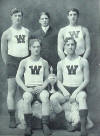 The winning 1903 crew: (standing left to right) Dan
Pullen, Skagway, AK; Coach Knight; Clinton Lantz, Chehalis, WA; (seated with
trophy left to right) Fred McElmon (stroke), Whatcom, WA; Karl Van Kuran
(Captain, Bow), Seattle, WA. Tyee photo.
The winning 1903 crew: (standing left to right) Dan
Pullen, Skagway, AK; Coach Knight; Clinton Lantz, Chehalis, WA; (seated with
trophy left to right) Fred McElmon (stroke), Whatcom, WA; Karl Van Kuran
(Captain, Bow), Seattle, WA. Tyee photo.
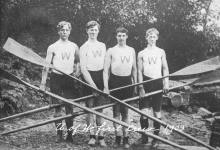 The four together
on the shores of Lake Washington, left to right Van Kuran, Pullen, Lantz,
McElmon. Lantz was credited by the P-I as "the fiercest line plunging
fullback ever playing on a Washington gridiron." (2) Tyee photo.
The four together
on the shores of Lake Washington, left to right Van Kuran, Pullen, Lantz,
McElmon. Lantz was credited by the P-I as "the fiercest line plunging
fullback ever playing on a Washington gridiron." (2) Tyee photo.
Downtown Seattle in 1903. Towards the top of the map, the grassy field with
"Public Library" written in it: that is the original site of the University of
Washington before moving to the
600-acre campus between Lake Union and Lake Washington in 1895. The UW tried to sell that
downtown property in 1893, but could not find a buyer due to the financial panic
that year. The regents ultimately ended up leasing the property, which
serendipitously led to the major development over the subsequent twenty years
of the core downtown area known as the "Metropolitan Tract" (still owned and
leased by the UW today). Meanwhile,
alumnus Edmond Meany (of Meany Hall fame) was able to secure funding from the
State Legislature - at the last minute - to purchase the northern acreage for
$28,314... and the new campus was born. “No campus in all the world can
equal Rainier Vista," Meany would say later in his life. "In those rare moments
when Mother Nature in kindly mood pulls aside the vaporous curtains we may gaze
upon Mt. Rainier, a flow sprinkled three-mile-high pile of rock and ice. A
spectacle of unending fascination!” (3)
Library of Congress; added 2/21
Added here for context to the above quote from Edmond Meany: Rainier Vista from a 1940's era postcard... a dream come true for the visionaries of early Seattle and the University of Washington. HRF collection and photo; added 2/22
Sources: 100 Years on Montlake; Tom Griffin, UW Magazine; September 1995 (3); The Seattle Post Intelligencer, April 26, 1903, pg. 14 (2); May 31, 1903, pg. 15; June 4, 1903, pg. 1 (1); The Tyee, 1905, (Rowing, pg. 179); The Tyee, 1907, (Rowing, pg. 112)
![]()
1904
All four of the members of the championship crew of 1903 were back for the 1904 season. In addition, the team had purchased, through the gifts of local businessmen, their first four-oared racing shell from Cornell for $400, delivered by rail.
Three races were held in the spring of 1904, the first being held on the Oakland Estuary in a one and a half mile race with California. Washington brought their new shell, but California still only owned barges. After discussions, it was decided that Washington would borrow a barge from California and the race would be barge on barge. Now, however, California was afforded the advantage as they rowed in a brand new boat, with Washington borrowing an older boat with a "leaky condition" (1). California subsequently won the race, but coach Knight said after the race "We wish it understood that Washington did not have and has not the slightest criticism to offer against California because of the unfortunate arrangements as regards boats. It will be remembered that California showed a thoroughly sportsmanlike spirit in rowing under similar adverse circumstances a year ago." (2) That last statement is likely a reference to the pre-race "row-over" California faced and the steering issues with her barge in the 1903 race.
The crew came home and raced in their shell on May 24th in Victoria B.C. against the James Bay Club Seniors, losing that race by a half length. Although the James Bay Seniors were a club boat made up of older, experienced oarsmen, Washington was very much in this contest even after colliding with a spectator's craft (in the course) during the race.
Six days later the crew raced the Portland Rowing Club, finishing their season on a high note with an easy win on Lake Washington.
Although the record may not reflect it, 1904 was a solid year for rowing at Washington and for the intercollegiate sport as a whole. Not only did Washington field a strong group of athletes and a new racing shell, they had arranged the finances to transport the team to California and back. Coach Knight noted shortly after the California race that "the California men were unanimous in praise of the Washington men for rowing at all simply for the sake of the sport". (2) And as plans were drawn up ensuring that in all future races each school would be responsible to supply their own fastest shell possible, the P-I noted "An outcome of the recent aquatic carnival is the decision by the boating associations of Washington, California, and Stanford to induce an Eastern boat builder to come to San Francisco... where he will devote himself to manufacturing Eastern model shells. California and Stanford are both anxious to have regulation four-oared shells to match Washington's boat at the next regatta." (3)
The era of the "barge" race was over, as both California and Stanford would subsequently acquire racing shells for the coming years.
The men in their new shell. Left to right (bow to stern) are Van Kuren (captain), Pullen, Lantz, and McElmon. Tyee photo.
This is a good representation of a "barge".
This picture was taken around 1912, with a coxswain; intercollegiate fours
racing at the turn of the century did not include coxswains.
VBC Collection: UW21859z.
2nd Avenue and Yesler Way in Downtown Seattle, 1904. Library of Congress; added 2/21
Sources: The Seattle Post Intelligencer, May 9, 1904, pg. 3 (2); May 10, 1904, pg. 15 (3); The Tyee, 1905, (Rowing, pg. 179); The Tyee, 1906, (Rowing, pg. 114); The Tyee, 1907, (Rowing, pg. 112) (1); The Log of Rowing at the University of California Berkeley, 1870-1987, pgs 4-9.
![]()
1905
With the graduation of Van Kuran and Lantz, Coach Knight was forced to look for new candidates to fill the Varsity four. As the sport was growing in popularity, so too did the number of men turning out for the chance to fill the vacant seats.
On April 15th the men, after traveling to San Francisco via steamer, lined up on the Estuary to face California. In a sea of whitecaps and driving rain, a strong California crew went on to defeat Washington by about three lengths over a two mile course. Two days later, on a calm Sausalito Bay, the crew faced Stanford (who had earlier refused a three school race on the Estuary), Washington this time winning by about a length.
On May 24th the team met the James Bay Seniors again, and defeated the crew at Victoria in a warm up to the west coast intercollegiate championships to be held May 30th on Lake Washington. The team felt much improved and confident.
The final race of the season, in front of an estimated 15,000 - 20,000 spectators, is really best described by the 1907 Tyee: "When the starting signal was fired on May 30 and the Washington crew started out like a flash and left California a good five lengths at the mile mark, the Washington supporters were mad with joy. The fellows were pulling easily with that long, swinging stroke of Knight's, and gained at every stroke. But soon curiosity got the better of judgment with one launch man, and he butted in alongside the crew throwing water in all directions. Other launches followed, and it wasn't long before the rudder string was broken and the boat half full of water. But the fellows kept on and managed to finish second to California. At the finish the Washington boat swamped, throwing the crew into the water. Stanford finished third."
California won by about ten lengths - the distance of sixteen lengths all being made up in the last part of the race as Washington struggled to keep their bow straight and their shell afloat, with the now swimming Huskies beating Stanford to the line by a length. Stanford did, however, win the first ever Freshman race, with Washington coming third.
As disappointing (and bizarre) as the end of 1905 was, it solidified intercollegiate rowing as a major sport on the west coast. It was after California's success in 1905 that the Associated Students at California moved their sport from a club sport to a varsity sport in the athletic program, and led to the funding and acquisition of three eight-oared shells by the University of California in 1906 (delivered in 1907).
The 1905 Varsity 4. Tyee photo.
The Varsity men left to right (stroke to bow): Dan Pullen (captain), Owen Crim, Guy Tilton, Dick Gloster. Said Knight of Pullen: "Dan Pullen pulled the best oar of anyone in crew, and he could step into any college boat in the world today and pull any oar. He is one of the best oarsmen I ever saw." (1) Tyee photo.
Sources: The Tyee, 1906, (Rowing, pg. 114); The Tyee, 1907, (Rowing, pg. 112) (1); The Tyee, 1908, (Rowing, pg. 111) The Log of Rowing at the University of California Berkeley, 1870-1987, pgs 4-9.
![]()
1906
With the departure of Coach Knight and Dan Pullen after the 1905 season, the rowing team suddenly found itself without a coach and without the fierce competitiveness and skill of the first three-year letterman in the sport at Washington. Stepping up were George Strange and Mark O'Dell, who with the help of General Manager Loren Grinstead, oversaw the program, and selected a crew (1).
The team was improving and was eager to travel to San Francisco to meet California and Stanford when they received a wire telling them that the races were cancelled due to an earthquake on April 18th. It was weeks later before the dejected oarsmen knew the extent of the 1906 San Francisco earthquake (7.8 Richter Scale) and fires - a disaster that claimed an estimated 3,000 lives and did $500 million (1906 dollars) in damage.
Although the team tried to salvage the season with races in Portland and Victoria, both races were subsequently cancelled.
Even though no official results were recorded for 1906, there was one off-the-water event that would mark the beginning of a legendary time in the history of Washington rowing. Hiram Conibear, a former professional bicycle racer, and trainer for the Chicago White Sox, was hired in the fall of 1906 to become trainer for the football and track programs at Washington. When Mr. Grinstead approached Conibear about the head coaching job for the rowing team, Conibear was typically straightforward: "I never did nothing but row a boat around a lagoon in Chicago" he said, "but if you want me, I'll do what I can." (2)
Thus began the Conibear years at Washington.
The 1906 Varsity 4, left to right, stroke to bow: Morris Christy, Bill Kirby, Jack Lowry, Dick Gloster (captain). Tyee photo.
On the lake. Tyee photo.
Possibly in preparation for a pre-season class or
University social event. Tyee photo.
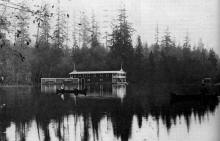 |
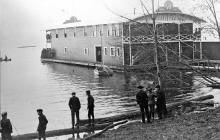 |
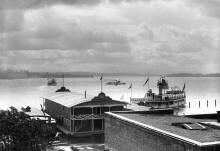 |
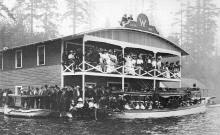 |
Four images of the original boathouse on Union Bay, very near where Conibear
Shellhouse stands today.
This boathouse was chiefly funded by the Blaine and Denny families of Seattle,
with the addition to house eight oared shells paid for by Miss Margaret Denny
herself. UW Rowing
Photos; added 2/21
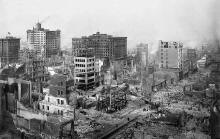 |
 |
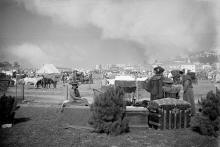 |
Damage from the San Francisco earthquake/fire on April
18, 1906, an earthquake still considered one of the most powerful (estimated
between 7.8 and 8.3 on the Richter Scale) and violent
(rated a rare "extreme" on the MMI intensity scale) in modern history.
70% of the city's 410,000 residents were displaced, and fires burned for four
days and nights, destroying 80% of the city.
Photos courtesy Wikimedia Commons;
added 2/21.
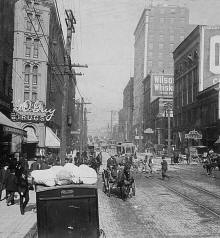 Seattle
1906: cobblestone streets, streetcars and buggies. Library of
Congress; added 2/21
Seattle
1906: cobblestone streets, streetcars and buggies. Library of
Congress; added 2/21
Hiram Conibear, the new Football and Track and Field Trainer (and part-time crew coach) at Washington in the fall of 1906, at the age of 35. Things were about to change. Library of Congress; added 2/21
Sources: The Tyee, 1907, (Rowing, pg. 112) (1); The Tyee, 1908, (Rowing, pg. 111); Video, The History of Washington Crew, The Beginning to 1970 (2).
![]()
1907
The 1907 season was the first for coach Hiram Conibear and also the first year that the team would row in eight-oared shells. Conibear, a trainer by trade, knew that conditioning would be critical to the success of his eight-oared teams, particularly now that the races would be four mile events - more than twice the distance of the one and a half mile fours race.
Without a launch to follow the crews, Conibear would stand on the shore and shout directions as the crew rowed by. The "colorful" language he used was not appreciated by homeowners near the lake, and complaints were registered with the University.
But not everyone was alienated. Through the generous donations - or "voluntary funds" as Conibear called them - of the Seattle business community, the program was able to purchase from Cornell two eight-oared shells. The shells were delivered by railcar, along with three shells destined for the University of California that arrived there three days later. The west coast would now see eight-oared racing for the first time, in an annual race that would become known as the Triangular Regatta, between Washington, California, and Stanford.
Unfortunately, what the west coast would see in the first Triangular eight-oared event would be a water fight on San Francisco Bay. The course was two and a half miles on what was deemed a neutral course - Richardson Bay near Sausalito, i.e. San Francisco Bay - on a spring day. The day of the race, April 27th, the wind was blowing hard from the northwest and the Bay was awash with whitecaps.
The premature cannon boom sounding the start of the race, while Washington was backing and Stanford was virtually perpendicular to the course, was only a precursor to what was to come. Although California got off ahead, the other crews quickly caught her. As the teams continued down the course, it was impossible to keep the water out. Slowly the boats were sinking, as wave after wave washed over the gunnels, and the athletes were soaked. Finally, an already third place California went down. Although further down the course, Stanford also swamped and then, finally, leading the race and struggling to stay afloat with only about a half mile to go, the Washington shell dove into the water, submerged to the oarlocks. The race was over.
The S.S. City of Puebla, the steamship Washington had taken to California, quickly gathered the men from the water. Surprisingly, however, the ship's crew also brought the shell up, and as all were left wondering about a re-row, the steamship set off back home for Seattle. She had already postponed her sailing for the crew race and the captain was not delaying the departure further.
The following Monday morning, under much better conditions, Stanford and California raced with the understanding that the winner would go to Seattle to race Washington for the west coast championship. Stanford went on to win by six lengths.
A few weeks later, amid the now traditional Seattle flotilla of watercraft and the crowds (estimated at 20,000 people) lining the four mile, Leschi to Laurelhurst Point course, the championship went out under excellent conditions on June 2nd. Included on one of the ships was "A party of special interest and importance... consisting of Gov. Albert E. Mead and party, Adj. Gen. James A. Drain and a large representation from the fifty prominent businessmen of the city who were the recent donors to the University of Washington of the shell in the race." (1)
Following a spirited start, Washington gradually moved ahead while under stroking her competitor, a sign that Conibear's conditioning program had paid off. The crew crossed the finish line about three lengths ahead of Stanford in 23:38, and were crowned champions of the west before a jubilant Seattle crowd.
An elated Conibear said after the race: "In my mind, Stanford did not have a single man on her crew who can pull an oar with Paul Jarvis, Hart Willis, or Homer Kirby. My rowing motto is not a new one in figuring up the essential winning qualities: 'Hard work first; ability, second, and genius, third." (1)
A season that had started out so dubiously had ended
with the biggest win in the history of the program, and would set the stage for
Conibear to take his teams to new heights.
Downtown Seattle in 1907. Library of Congress; added 2/21
Washington sporting new shirts, a new shell, and new painted oars. This is the first known picture showing the white blades of Washington. Although not officially documented, it is very likely the paint was chosen by the pragmatic Conibear for function over form: in the winter darkness of a rainy Seattle morning, white blades show up better... especially for a coach without a launch forced to watch - and coach - from shore. Tyee photo.
A collection of the portraits from the Tyee, featuring the 1907 varsity.
From left, Coach Conibear; Walt Dunbar, cox; stroke) Dick Gloster,
7) Dobs O'Brien, 6) Bill Kirby, 5) Paul Jarvis, 4) Hart Willis, 3) Bart Lovejoy,
2) George Sadler, bow- Doak Lowry; Walter McLean, 2nd team cox.
Tyee photo.
Postcard photo of the 1907 varsity. WRF photo, added 2/21
Walt Dunbar coxed the first eight-oared race for Washington, then left the team, came back in 1911, and finished his career in 1914. There were no limitations on eligibility, and Dunbar became a valuable asset for Conibear as the years progressed. Husky Crew Foundation photo: Erickson collection.
A small leather scrapbook with pictures from the trip to San Francisco, put together by one of the athletes. VBC Collection.
 Preparing to launch. By the looks of the water
this is likely not the day of the race.
VBC Collection: UW21761z.
Preparing to launch. By the looks of the water
this is likely not the day of the race.
VBC Collection: UW21761z.
Dick Gloster, three time letterman, twice captain,
relaxing on the deck of the S.S. City of Puebla.
The steamship made twelve knots, which would put the journey from Seattle to San
Francisco about three to four days. At 1700 tons, the ship would be
dwarfed by modern day passenger ships - and would make for a not so fun ride in
an April storm in the open Pacific.
VBC Collection: UW21759z.
On the deck of the steamship, preparing the shell for the first eight-oared regatta on San Francisco Bay. VBC Collection: UW21760z.
Probably taken either right before departure or right before disembarkation. Coach Conibear, known for his colorful language, is highest row, left, (hat cut off) with mouth just open - maybe telling the photographer to take the #&!* picture. Tyee photo.
The team relaxes onboard. Captain Dick Gloster wears the sweater with the largest "W" on it; 1908 Captain Bill Kirby is on the railing with the striped pants. Tyee photo.
Plenty of legroom on a steamship, it just takes three days to get there instead of three hours. "City of Puebla" can be seen in lettering on the life-ring. Tyee photo.
Washington nearing the finish line back home on Lake Washington to win the first ever eight-oared west coast championship against Stanford on June 2nd, 1907. Tyee photo.

Hiram Conibear, an athletic trainer by profession, was hired from Chicago to be
head trainer for the Washington football and track teams, and became crew coach
only after arriving in Seattle, and mostly as an afterthought. Here, back row, fifth from the left, Conibear stands with the 1907 football team. Tyee photo.
Sources: The Tyee, 1909, (Rowing, pg. 118 - 127); The Seattle Post Intelligencer, June 3, 1907, pg. 10; The Log of Rowing at the University of California Berkeley, 1870-1987, pgs 4-9.
![]()
1908
With new found confidence the team embarked on the 1908 season eager to prove that 1907 was not a fluke. Fifty-four men turned out (thirty-two Varsity and twenty-two Frosh) and the newcomers were immediately set out in the training barge which, incidentally, was already known as "Old Nero". Conibear extended his training season to six months - previously crews would train from February or March through the season (four to five months), and for the first time would follow the team during practice in a new (leased) launch, The Target.
Washington did not travel to California this year, instead agreeing to pay the expenses of the California/Stanford winner to come north. California won that race going away, and came to Seattle to meet Washington for the coast championship on June 2nd, 1908, this time over a three-mile course (Conibear wanted the IRA distance of four miles but California did not, so the resultant three miles was a compromise).
The course on Lake Washington was ideal. The crews were lined up near Leschi, and after a clean start California began to inch ahead. At the mile mark, California led by 3/4 length, but the telling difference was borne out by stroke rates: California rowing a 38, Washington rowing a 34. Early in the second mile Washington began to move, still under stroking her rival, and pushed through California. By the two-mile mark Washington had increased the lead to three lengths. In a time of 17 minutes and 10 seconds, Washington claimed the west coast championship, finishing amid the blaring sounds of the crowd following in boats and watching onshore, with an experienced and highly regarded California crew about five lengths behind.
The 1908 crew had trained harder than it's predecessors and is probably the first team to actually use a primitive version of the now famous "Conibear stroke" - a stroke that, although it was ever evolving, began developing by exchanging an exaggerated layback for a smoother, more fluid recovery into the catch. The combination of training, common sense, curiosity - and his newfound passion for and detailed mechanical analysis of the sport - Conibear built a crew that likely could have raced with the best in the nation. It would take a few more years before he would take his men back east to prove it.
Meanwhile, on the other side of the world outside of London, England, a seventeen year-old boy was busy building his own scull out of Norway pine and mahogany in anticipation of entering a professional rowing race that spring. As his father watched his work, he noted to the boy "No one will ask you how long it took you to build it, they will only ask who built it". In other words, take your time, do it right. (1)
That young man was George Yeoman Pocock, who two months later would row that scull against fifty-eight competitors - and win. Along with the glory of victory came a fifty pound-sterling purse. The sponsors of the race, The Sportsman newspaper, noted "Young Pocock was undoubtedly aided by the excellent ship he utilized." (1)
Two years later Pocock would use the remaining thirty pounds of the purse he won that day to book one-way passage to Canada, with his brother Dick, to start a new life in British Columbia. Said Pocock later in life "I guess I was justified telling people in later years that I rowed my way from England to Canada". (1)
And, with a little help from Hiram Conibear, eventually to the shores of Lake Washington.
An artist's illustration of the uniforms and oars of the established collegiate rowing teams in the United States in 1908. Missing from this depiction: Washington and California, but not intentionally. In 1908, neither team was on the map; but in twenty years, the UW and Cal - both rowing the "Conibear Stroke" - would be dominating the sport. Library of Congress; added 2/21
The 1908 Varsity Crew. VBC Collection: UW21764z.
All lined up with nowhere to go. This crew, after
defeating a good California crew convincingly for the west coast championship,
wanted to go to the IRA, but were not granted an invitation. UW Rowing photo.
Added 2/21
The 1908 Varsity crew: left to right:
Doak Lowry, Arthur O'Neal, Bart Lovejoy, Hart Willis, Arthur Karr, Broussais (Brouse) Beck,
Lloyd O'Brien, Homer Kirby (Captain), Everett Thompson (cox),
and Coach Conibear. Based on this team's 1908 performance, a statement was
published in the Tyee that would prove prophetic: "The future of
rowing is particularly bright. All natural advantages lend themselves to its
development. The lake washes the east border of the campus, and the climate is
so mild that it permits continuous winter training on the water, an advantage
enjoyed by few colleges. Our navy is better and larger than ever before. The
ASUW now owns a coaching launch, two eight-oared shells, two eight-oared barges,
one four-oared barge and one four-oared shell. With constantly growing
equipment, a place to train second to none in the United States, an ever
increasing spirit for rowing in the student-body, and a coach in whom we all
place explicit faith and confidence, Washington bids fair to become a premier
rowing institution in the United States." UW Rowing photo.
Added 2/21
More tall timber. This western red cedar - at least ten feet in diameter and likely over 120 feet tall - was already on the way to the sawmill when over 40 men had their photo taken on the stump. The destination for the tree was quite possibly the "Town of Yesler", a thriving small community built around Henry Yesler's Lake Washington sawmill, located just across Union Bay from the UW shellhouse, less than a half-mile away. The mill was bustling and loud, with giant logs floated in, or arriving by railcar (off of a spur of the railroad that is now the Burke-Gilman trail), with the finished lumber taken out by rail. About sixty homes made up the town that was first founded in the late 1880's (best described today as the lower Laurelhurst neighborhood bordered by NE 41st and NE 45th, annexed to Seattle in 1910), almost all residents employed by the mill. The mill itself went through various owners (and fires); in 1908 it was likely a cedar shingle mill, before the lowering of the lake in 1916 put an end to the business. Today the area is known as the "Yesler Swamp"... or more endearingly: The UW Center for Urban Horticulture. More on the Town of Yesler is here: History LInk: Yesler Mill on Union Bay and another interesting article is here: Making the Cut - The Yesler Mill on Union Bay. WRF photo, added 2/21
Henley on Thames in 1908. "My father put me in a single shell when I was twelve years old and I took to sculling very readily. I rowed my first race when I was fifteen, a junior race in the (1906) Henley on Thames town regatta, and won it," (1) said George Pocock in his memoirs. In 1908, George was an apprentice boatbuilder in his dad's shop at Eton College. "There were absolutely no power tools, no machinery of any kind," Pocock remembered. ""Everything was done by hand, and to me the smell of the wood was sweeter than any perfume: Norway pine for the stringers, white ash for ribs and shoulders, and Spanish cedar for the skin and washboards." (1) Washington Rowing Photo, added 2/21
Sources: The Tyee, 1909, (Rowing, pg. 152 - 158); The Tyee, 1924, pgs. 152-163; VBC Log Book, 1916-1925, MSCUA; The Log of Rowing at the University of California Berkeley, 1870-1987, pgs 4-9; Ready All! George Yeoman Pocock and Crew Racing, pgs. 12-14 (1).
![]()
1909
"Fall training for the crews was inaugurated by Coach Conibear and Nero was fitted with a canvas top much against the wishes of the coach who wanted the men to toughen earlier..."- so says the Tyee (1), referring to the autumn of 1908 as the team prepared for the 1909 season. Conibear even complained that although the men had good form, they "did not have the strength to fight wind and rough water or stand much cold weather". (2)
Whether that was the case or not, there certainly was plenty going on around campus during the 1908-09 season to distract them. The Alaska/Yukon Exposition (World's Fair) was set to open on June 1st, 1909, and the campus would be the venue for this event. Tens of thousands of visitors from around the world were expected, new buildings were popping up everywhere, and President William Howard Taft himself would open the festivities. Click here to learn more about the AYE and the impact on the University of Washington: HistoryLink (type in "exposition" in the search box in the upper right corner).
Months went by, with the team training together both on and off the water. Come race day - after about eight months of training with only interclass competition - Conibear's now over-hyped, over-trained, and under-weight crew (they averaged 167.5 pounds) was set to go, against a Stanford crew that averaged 187 pounds. The race - scheduled for May 29th - was postponed two days due to wind, leaving thousands of Sunday spectators disappointed as they waited all day for an event that was finally postponed. Coincidence or not, the race would now be held May 31st, one day before the AYE would open.
The three mile course started a half mile below Leschi Park, with the finish at Madison Street. On the day of the race, a fresh north wind blew straight down the course. Although scheduled to go at 2:30 p.m., the start was again delayed until 5:30, at which time it was down to now or never. The crews were aligned and started.
Both crews were quick off the line at a 38 (strokes per minute), with Washington settling to 34/33, and Stanford at a 36. The two crews rowed distinctly different styles, with Washington's stroke now described by the Post Intelligencer writer as "noticably smoother than the cardinal's, and the shell stopped less between strokes". (3)
But as the crews rowed straight into the north wind, Conibear watched as his earlier observations about his young team began to manifest. As the fiery coach looked on in what must have been agony from The Target (now owned by the program), the less efficient yet much stronger Stanford crew just slowly moved ahead in the heavy chop. Even after Stanford was forced to maneuver around some questionable boaters and their wake, the crew maintained their lead. There was nothing Conibear could do but watch, as the race unfolded slowly and deliberately. Stanford crossed the line still fighting the headwind and chop in a grueling 19 minutes 40 seconds - twelve seconds in front of Washington.
All Conibear would say after the race was "It was Stanford's water, but they rowed fine".
The year ended as a bitter disappointment for Conibear. The hope of a growing dynasty was stunningly abbreviated that day, and had to put into question the training regimen of the coach. In addition, Conibear, who had been a staunch supporter of the four-mile race, was forced to accept the three-mile race as the de-facto distance in Varsity events on the west coast for the remainder of his tenure.
But anyone thinking any of this might alter his vision, or possibly re-shorten the training year, would be disappointed. As a trainer by profession, Conibear was learning from this experience about optimizing athletic performance on the water - and the importance of fielding larger, stronger men in open competition. It seems clear in hindsight this crew had peaked weeks if not months ahead, and was overpowered by just frankly a much bigger crew. So with a new contract in hand from the University (he now was teaching rowing to over one hundred students - men and women - as part of their required gymnasium course) and a re-commitment to the program, Conibear entered the new decade seeking to define his role at Washington.
The 1909 Varsity Crew, who, if they would have dropped another three pounds per man, would have qualified as a lightweight team. Given another couple of weeks on Conibear's 1909 training regimen they probably would have. The crew from left to right: Thompson (cox), O'Neal, O'Brien, Beck, Wyckoff, Catlin, Godfrey, Mohr, Lovejoy. VBC Collection: UW21766z.
The coxswain or stroke oar was required by Conibear to
summarize the day's workout. These notes were bound so that the coach had
a record of individual performance and weight over the course of the year.
This page, from the freshman workout on March 20th, 1909, indicates room for
improvement. These books, from 1909 to 1913 can be found in the VBC
Collection at the MSCUA (archives) at Suzzallo Library. (See next picture
for more detail.) VBC Collection: Accession # 3368-2, Box 15.
Here is the first entry on the page above from Ralph Randall, freshman coxswain (the lineup from stern to bow was Wright, Buwaldo, Godfrey, Pullen, Husky, Doust, Bean, and Bonney): "Rowed out of bay to Leschi. Rough weather: crew improved in catching together + also ride boat a little better. Doust on ki-bosh because he had grip* yesterday is is (sic) full of quinine. He starts level at catch too soon + makes it not sufficiently snappy. Bean leans badly to starboard. Lots of water in boat by finish. Ralph R. Randall, Cox. N.B. Crew has had bad habit of stopping occasionally. R.R.R." * "grip" as used here is referring to influenza like symptoms. VBC Collection: Accession # 3368-2, Box 15.
On the back this picture reads "Beck and Thompson" and was likely taken to reveal the contrast between the short and tall; Broussais (Brouse - pronounced 'Bruce') Beck, rowing no. 6, was one of the tallest members of the team (yet weighed 161 pounds on race day), and Everett Thompson was the varsity coxswain.
Everett Thompson tragically died in 1910 and was eulogized by Edmond Meany (the "Father of UW Forestry" and namesake of Meany Hall) in the 1911 Tyee as "one who unconsciously, naturally and constantly obeyed the rule 'Thy neighbor as thyself'." VBC Collection: UW21765z.
Sources: The Tyee, 1911, (Rowing, pg. 134-139) (2); The Tyee, 1924, pgs. 152-163 (1); The Seattle Post Intelligencer, May 28, 1909, pg. 10; May 29, 1909, pg. 10; May 30, 1909, pg. 4; June 1, 1909, pg. 1 (3).
![]()
This website, and all history and other content are copyrighted © 2001 - 2021 by the Washington Rowing Foundation and Eric Cohen. Sources and pictures are credited, and any reproduction must be approved by the owner.
The Washington Rowing Foundation is a non-profit 501 C (3) corporation supported by volunteers, and all proceeds from donations go to the Washington rowing team. Thank you for supporting Washington Rowing.
| Home | Contact Us | © 2001 - 2023 Washington Rowing Foundation |